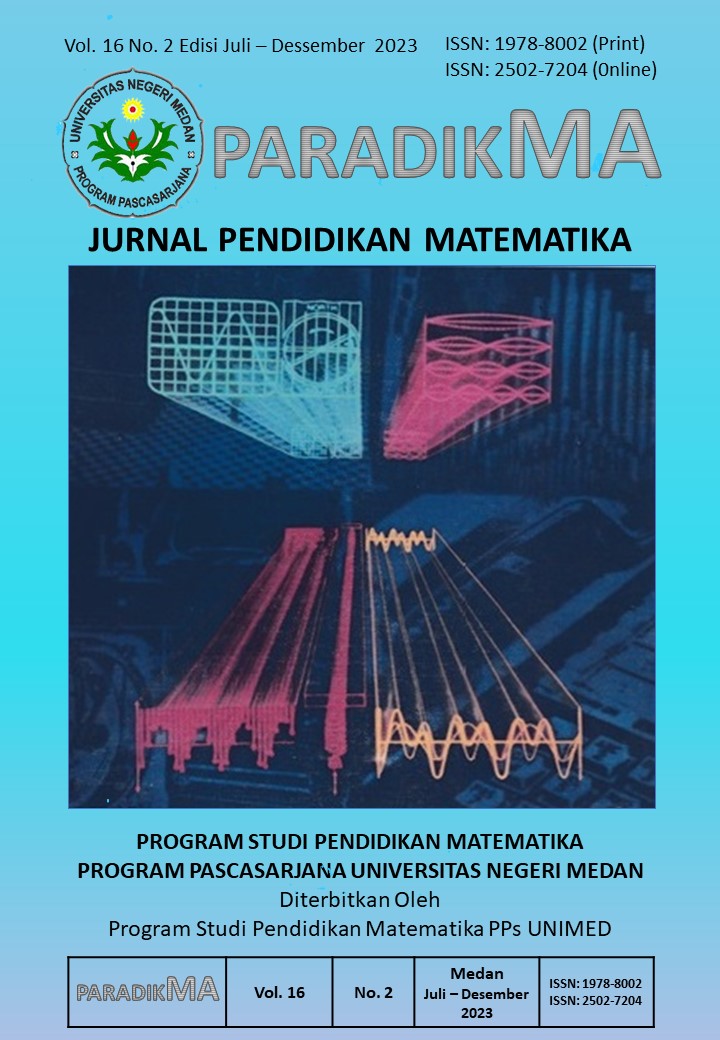Development of Cooperative Learning Tools Type Course Review Horay and Geogebra Media to Improve Spatial Thinking Skills and Mathematical Resilience of Grade VIII Students
DOI:
https://doi.org/10.24114/paradikma.v16i2.48947Abstract
This study aims to investigate the improvement and development of spatial thinking skills and mathematical resilience abilities of students using cooperatively developed learning tools of the Course Review Horay and Media Geogebra type; to investigate the validity, practicability, and efficacy of cooperatively developed learning tools of the Course Review Horay and Media Geogebra type in enhancing spatial thinking skills and resilience. This type of research is development research based on the ADDIE model. 33 MTs Al-Washliyah Tembung students participated in the study. The results demonstrated that 97% of the students, or 32 out of 33, improved their spatial reasoning skills. While only 19 of 33 students, or 58%, exhibited an increase in mathematical resilience. In addition, the results indicate that this development model is more effective than conventional classroom learning models at enhancing spatial reasoning and mathematical resilience. The learning aids created using cooperative Course Review Horay type and Geogebra are valid, applicable, and efficient.Keywords: ADDIE, Spatial Thinking Skills, Mathematical Resilience, Development ResearchReferences
Akbar, S. (2016). Learning Device Instruments. Rosda Works.
Amalia., Surya, E and Syahputra, E. (2017). The Efectivness of Using Problem Based Learning (PBL) in Mathematics Problem Solving Ability For Junior High School Student. International Journal of Advance Research and Innovative Ideas in Education, 3, No. 2.
Ariyanto. (2018). Analysis of Free Orientation and Student Recilience in the Mathematics Learning Media Development Course. Scientific Journal of Mathematics Education, 3(1), 29-36.
Darda S. and Adi S. (2013). The Constitution of the National Education System and its Applications. AR-RUZZ MEDIA.
Eviyanti, Y. C., Surya, E., Syahputra, E and Simbolon, M. (2017). Improving The Students' Mathematical Problem Solving Ability by Applying Problem Based Learning Model in VII Grade At SMPN 1 Banda Aceh Indonesia. International Journal of Novel Research in Education and Learning., 4 No 2.
Gutierrez, A. (2017). Visualization in 3-dimensional geometry. Proceedings of the 20th Conference of the International Group for the Psychology of Mathematics EducationI, 3 (20).
Hamiyah, N. and M. J. (2014). Teaching and Learning Strategies in the Classroom. Bibliography Achievements. Hasratuddin. (2015). Why Study Math? Prime Publishing.
Hutauruk, A. (2013). Student Mathematical Resilience Behavior through a Problem-Based Learning Model with a Metacognitive Approach. Journal Of Mathematics Education and Applied., 1 (1), 7“16.
Ministry of Education and Culture. (2013). Permendikbud Number 65 of 2013 concerning Process Standards.
Kusfabianto, I. (2019). Application of Horay Course Review Learning Model to Improve Activeness and Learning Outcomes of Grade IV Elementary Mathematics. Journal of Mathematical Theory and Applications., 3 (2), 87“92.
Lestari, K., E., and Yudhanegara, M., R. 2017. (2017). Mathematics Education Research. Refika Aditama.
Linn, M., and Petersen, A. (2015). Emergence and characterization of sex differences in spatial ability: a meta-analysis. Child Development, 56(6), 1479-1498.
Minister of Education and Culture. (2016). Number 22 of 2016 concerning Education Assessment Standards.
Rusdewanti, Panca Putri, and A. G. (2014). Development of Music Art Interactive Learning Media for Junior High School Students. Journal of Educational Technology Innovation, 1(2), 153-164.
Saragih, S. &; Habeahan, W. L. (2014). The Improving of Problem Solving Ability and Students' Creativity Mathematical by Using Problem Based Learning in SMP Negeri 2 Siantar. Journal of Education and Practice. http://www.iiste.org/Journals/index.php/JEP/article/viewFile/17463/1772
Setyaningsih, R., &; Rahman, Z. H. (2022). The influence of the problem-based learning model on students' problem-solving abilities. Axiom: Journal of Mathematics Education Study Program, 11(2), 1606-1619.
Simamora, R. E., Saragih, S., &; Hasratuddin, H. (2018). Improving students' mathematical problem solving ability and self-efficacy through guided discovery learning in local culture context. International Electronic Journal of Mathematics Education, 14(1). https://doi.org/10.12973/iejme/3966
Soedjadi, R. (2014). Strengthening School Mathematics as a Wahan of Education and Reasoning Culture. National Mathematics Education Media. Susilawati. (2021). Strategy-Based Mathematics Course Review Horay (CRH) Arithmetic Material Class XI SMA N 4 Palopo. PPs. IAIN Palopo.


